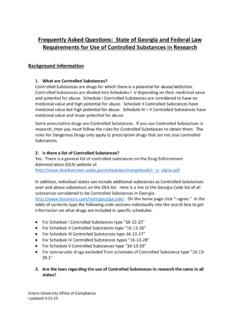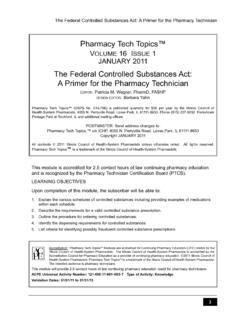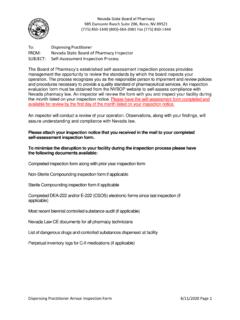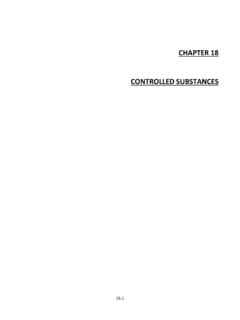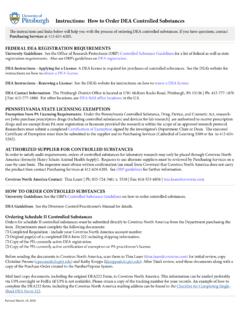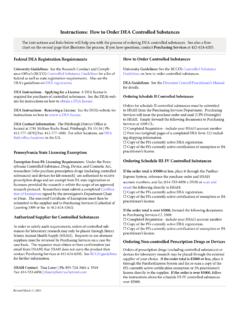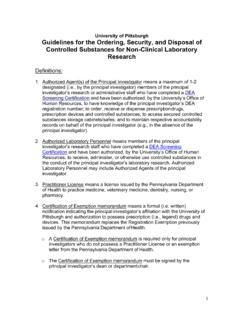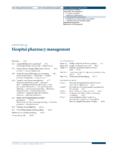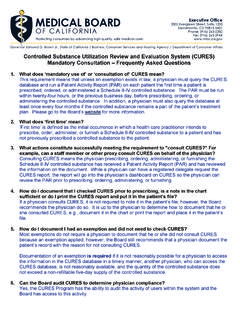Transcription of 2016 - Notice of Intent: Temporary Placement of ...
1 SearchHOMEREGISTRATIONREPORTINGRESOURCES ABOUT USRESOURCES > Federal Register Notices > Rules - 2016 > Notice of Intent: Temporary Placement of Mitragynine and 7-Hydroxymitragynine Into Schedule IRules - 2016[Federal Register Volume 81, Number 169 (Wednesday, August 31, 2016)][Proposed Rules][Pages 59929-59934]From the Federal Register Online via the Government Publishing Office [ ][FR Doc No: 2016-20803]DEPARTMENT OF JUSTICEDrug Enforcement Administration21 CFR Part 1308[Docket No. DEA-442]Schedules of controlled Substances: Temporary Placement of Mitragynine and 7-Hydroxymitragynine Into Schedule IAGENCY: Drug Enforcement Administration, Department of : Notice of : The Administrator of the Drug Enforcement Administration is issuing this Notice of intent to temporarily schedule the opioids mitragynine and7-hydroxymitragynine, which are the main active constituents of the plant kratom, into schedule I pursuant to the Temporary scheduling provisions of the ControlledSubstances Act.
2 This action is based on a finding by the Administrator that the Placement of these opioids into schedule I of the controlled Substances Act isnecessary to avoid an imminent hazard to the public safety. Any final order will impose the administrative, civil, and criminal sanctions and regulatory controlsapplicable to schedule I controlled substances under the controlled Substances Act on the manufacture, distribution, possession, importation, and exportation of, andresearch and conduct of instructional activities of these : August 31, FURTHER INFORMATION CONTACT: Michael J. Lewis, Office of Diversion Control, Drug Enforcement Administration; Mailing Address: 8701 Morrissette Drive,Springfield, Virginia 22152; Telephone: (202) INFORMATION: Any final order will be published in the Federal Register and may not be effective prior to September 30, AuthorityThe Drug Enforcement Administration (DEA) implements and enforces titles II and III of the Comprehensive Drug Abuse Prevention and Control Act of 1970, asamended.
3 21 801-971. Titles II and III are referred to as the " controlled Substances Act" and the " controlled Substances Import and Export Act,"respectively, and are collectively referred to as the " controlled Substances Act" or the "CSA" for the purpose of this action. The DEA publishes the implementingregulations for these statutes in title 21 of the Code of Federal Regulations (CFR), chapter II. The CSA and its implementing regulations are designed to prevent,detect, and eliminate the diversion of controlled substances and listed chemicals into the illicit market while providing for the legitimate medical, scientific, research,and industrial needs of the United States. controlled substances have the potential for abuse and dependence and are controlled to protect the public health the CSA, each controlled substance is classified into one of five schedules based upon its potential for abuse, its currently accepted medical use in treatment inthe United States, and the degree of dependence the drug or other substance may cause.
4 21 812. The initial schedules of controlled substances established byCongress are found at 21 812(c), and the current list of all scheduled substances is published at 21 CFR part 201 of the CSA, 21 811, provides the Attorney General with the authority to temporarily place a substance into schedule I of the CSA for two yearswithout regard to the requirements of 21 811(b) if she finds that such action is necessary to avoid an imminent hazard to the public safety. 21 (h)(1). In addition, if proceedings to control a substance are initiated under 21 811(a)(1), the Attorney General may extend the Temporary scheduling forup to one year. 21 811(h)(2).Where the necessary findings are made, a substance may be temporarily scheduled if it is not listed in any other schedule under section 202 of the CSA, 21 , or if there is no exemption or approval in effect for the substance under section 505 of the Federal Food, Drug, and Cosmetic Act (FDCA), 21 355.
5 811(h)(1). The Attorney General has delegated scheduling authority under 21 811 to the Administrator of the DEA. 28 CFR 201(h)(4) of the CSA, 21 811(h)(4), requires the Administrator to notify the Secretary of the Department of Health and Human Services (HHS) of hisintention to temporarily place a substance into schedule I of the CSA.\1\ The Administrator transmitted Notice of his intent to place mitragynine and7-hydroxymitragynine in schedule I on a Temporary basis to the Assistant Secretary by letter dated May 6, 2016. The Assistant Secretary responded to this Notice byletter dated May 18, 2016, and advised that based on review by the Food and Drug Administration (FDA), there are currently no investigational new drug applicationsor approved new drug applications for mitragynine and 7-hydroxymitragynine. The Assistant Secretary also stated that the HHS has no objection to the temporaryplacement of mitragynine and 7-hydroxymitragynine into schedule I of the CSA.
6 Neither mitragynine nor 7-hydroxymitragynine is currently listed in any scheduleunder the CSA, and no approved new drug applications or investigational new drug applications for mitragynine or 7-hydroxymitragynine exist, 21 355. TheDEA has found that the control of mitragynine and 7-hydroxymitragynine in schedule I on a Temporary basis is necessary to avoid an imminent hazard to public2016 - Notice of Intent: Temporary Placement of Mitragynine of 67/13/18, 8:19 AMHOMECONTACT USA-Z SUBJECT INDEXPRIVACY NOTICEWEBSITE ASSISTANCEREGISTRATIONA pplicationsToolsResourcesCMEA Required Training & Self-CertificationQuota ApplicationsABOUT USProgram DescriptionCustomer Service PlanDEA Forms & ApplicationsMailing AddressesMeetings & EventsWhat's NewREPORTINGARCOSBCM OnlineChemical Import/Export DeclarationsCSOS ( controlled Substances OrderingSystem)Drug Theft/LossImport/ExportMedical MissionsRegistrant Record of ControlledSubstances DestroyedQuotasReports Required by 21 CFRS ubmit a Tip to DEAYear-End ReportsRESOURCESC ases Against DoctorsChemical Control ProgramCMEA (Combat Meth Epidemic Act)
7 controlled substance SchedulesDATA Waived PhysiciansDrug Disposal InformationDrug and Chemical InformationE-commerce InitiativesFederal Agencies & Related LinksFederal Register NoticesNational Prescription Drug Take BackDayNFLISP ublications & ManualsQuestions & AnswersSignificant Guidance DocumentsSynthetic DrugsTitle 21 Code of Federal RegulationsTitle 21 USC Codified DEPARTMENT OF JUSTICE DRUG ENFORCEMENT ADMINISTRATIOND iversion Control Division 8701 Morrissette Drive Springfield, VA 22152 | | | Legal Policies and Disclaimers | DOJ Privacy Policy | FOIA | Section 508 \1\ As discussed in a memorandum of understanding entered into by the Food and Drug Administration (FDA) and the National Institute on Drug Abuse (NIDA), theFDA acts as the lead agency within the Department of Health and Human Services (HHS) in carrying out the Secretary's scheduling responsibilities under the CSA,with the concurrence of NIDA.
8 50 FR 9518, Mar. 8, 1985. The Secretary of the HHS has delegated to the Assistant Secretary for Health of the HHS the authority tomake domestic drug scheduling recommendations. 58 FR 35460, July 1, find that placing a substance temporarily into schedule I of the CSA is necessary to avoid an imminent hazard to the public safety, the Administrator is required toconsider three of the eight factors set forth in section 201(c) of the CSA, 21 [[Page 59930]]811(c): the substance 's history and current pattern of abuse; the scope, duration and significance of abuse; and what, if any, risk there is to the public health. 811(h)(3). Consideration of these factors includes actual abuse, diversion from legitimate channels, and clandestine importation, manufacture, or 811(h)(3).A substance meeting the statutory requirements for Temporary scheduling may only be placed in schedule I.
9 21 811(h)(1). Substances in schedule I are thosethat have a high potential for abuse, no currently accepted medical use in treatment in the United States, and a lack of accepted safety for use under medicalsupervision. 21 812(b)(1).Mitragynine and 7-hydroxymitragynine, the Main Active Constituents of the Plant KratomMitragynine and 7-hydroxymitragynine are the main active constituents of the plant Mitragyna speciosa Korth (commonly known as kratom), an indigenous plant ofSoutheast Asia. Kratom is the only known species of Mitragyna to contain mitragynine and 7-hydroxymitragynine. Kratom is abused for its ability to produce opioid-like effects. Kratom is available in several different forms to include dried/crushed leaves, powder, capsules, tablets, liquids, and gum/resin. Consequently, kratom,which contains the main active constituents mitragynine and 7-hydroxymitragynine, is an increasingly popular drug of abuse and readily available on the recreationaldrug market in the United States.
10 Attempted importations of kratom are routinely misdeclared and falsely labeled. This is similar to other attempts to import controlledsubstances or substances intended to mimic controlled substances. The amount of kratom material seized by law enforcement for the first half of 2016 greatly exceedsany previous year totals and easily accounts for millions of dosage units intended for the recreational market.\2\ Available data and information for mitragynine and7-hydroxymitragynine, the main active constituents of the plant kratom, and the plant kratom, are summarized below. Available information indicates that theseopioid substances, constituents of the plant kratom, have a high potential for abuse, no currently accepted medical use in treatment in the United States, and a lack ofaccepted safety for use under medical supervision.
